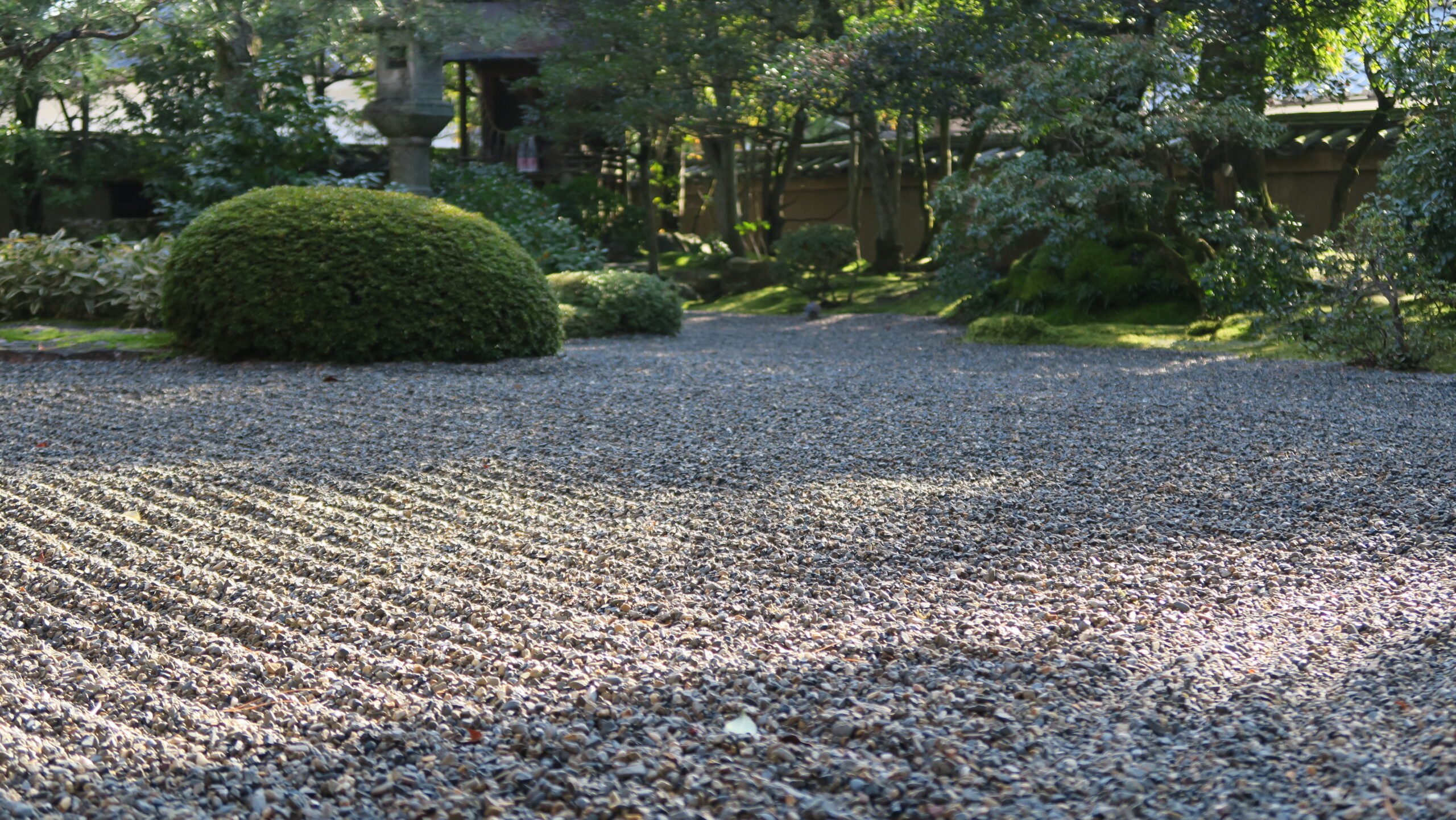In 1335, a few years after he abdicated the throne, the 95th emperor of Japan Hanazono (1297-1348) decided to become a Buddhist monk. He entered the Rinzai school of Zen Buddhism and donated one of his palaces, turning it into a temple complex. Almost 700 years later, the Myoshin-ji (妙心寺) complex houses almost 50 sub-temples, and lays just up the road from the JR Hanazono train station in northeast Kyoto, a station I used to frequent often when I was a student here in 1999.
Last Saturday, on a crisp morning with a cloudless blue sky, I wandered about the temple complex in search of Shunkō-in (春光院). A few times a month, the Reverend Taka Kawakami gives an introductory zazen (seated meditation) lesson in English. Having only done guided mediation on my own, listening to podcasts or books, I was really looking forward to trying zazen, especially under the guidance of a teacher.
The temple is not normally open to visitors, and I felt like I was trespassing as I opened the gate to step within the grounds (the sign said to do so!). Stepping into the entrance, a young woman in, jeans a warm striped sweater with white puffball earrings dangling from her ears greeted me in English, “Are you here for meditation class?” I removed my shoes and she showed me to a small room about 12 tatami mats big, with three heaters going. I removed both of my jackets.
There were about 20 thick round cushions sitting on the mats in neat lines, looking like a mass of go pieces. I kneeled to the side and listened to the birds in the garden. Their chirping was slightly louder than the oscillating sound of the heaters.
After a few minutes, a pair of Japanese women were shown in — tourists from Tokyo. Then a young, athletic American guy. Then a couple from Singapore. Finally, Kawakami-sensei entered, “Wow! We have a small group today! Let’s get started! Come up to the front, it gets cold in the back.”
Zazen is often imagined as an austere practice. Rows of silent, shaven-headed monks, stiffly lost in oblivion, a teacher prowling the lines with a wooden rod, ready to mete out decidedly non-judgmental corporal punishment. Right away, Kawakami-sensei set out to set the record straight, “You must throw away your stereotypes of mediation.” My stereotypes were already being challenged the moment he walked in. Kawakami-sensei is a small, thick-set man, with a wide smile and young face. He sports a wedding ring, an Apple Watch, and pair of fancy spectacles covered in sensors. The glasses monitor your “status of mind” and record the data via bluetooth to your smartphone.

Kawakami-sensei opens the session with a discussion on posture and flexibility, and the importance not only for bodily flexibility, but mental flexibility. Challenging your common sense, throwing away stereotypes, and changing your perspective is core to Zen.
Then he gives us some tips on posture and breathing, with footnotes on seratonin and the symptomatic and asymptomatic nervous systems, in preparation for the meditation session. You can get some of his tips from this animation of his:
Then there was a clack of two wooden slats slapping together — the “take your positions” signal — and Kawakami-sensei struck a long-handled bell. Then we sat.
Being an introductory session, the sitting was short, just 20 minutes. Surprisingly for me, it flew by. I was pretty amazed at how well I did. I barely shifted, and I was able to observe, acknowledge, and ignore the tingling in my lower legs and in my neck. But, I was pretty appalled with my ragged breathing. I breathe not with a smooth rhythm, but more like a drowning man.
Sensei said that when you are hunched over at your computer, or sitting looking at a smart device with your back curved, you are only using a third of your lungs’ capacity. Sitting up straight and breathing fully and completely is just something that we moderns are no longer used to.
The bell sounded again, and everybody returned to now. Kawakami-sensei then gave us an interesting sermon on breathing’s effects on concentration, and on happiness’s effects on success. He spoke about Dunbar’s Number and behavioural economics, and referenced research from Harvard and Oxford. Later, during tea, he spoke on the medical benefits of the amino acid Theanine which is found in Japanese matcha tea. When talking about focus and concentration, athletes and software developers featured heavily. Not a surprise for someone who has written a book on Zen for Business Elites. It was all very scientific. In fact, almost scientistic, which maybe is not a surprise for someone who spent eight years at Rice University and Arizona State University studying psychology and divinity.
Kawakami-sensei is a bit of a celebrity. He has his book, got lots of coverage for presiding over gay marriages in Japan, and last year spoke at TEDx Kyoto. Look at the pictures of him on his blog with famous actors and writers. He mentioned that he just met with U.S. Ambassador to Japan Caroline Kennedy the day before. Thus, he is very busy. We did not have much time to interact with him during the 90 minute session. He would deliver a talk, then his staff would come in and shuffle us to the next area, then he would come in a little later, speak some more, and then be gone again. It was a shame because I had so many questions for him, and greetings to deliver from mutual friends, but did not feel comfortable in front of the other tourists. Still, it was a good first Zen experience. He gave us a little tour of the temple, and we sat down and drank some matcha while viewing one of the gardens as a closer. It was all very relaxing and inspiring. If you are in Kyoto, I heartily recommend it.
Shunkō-in Gallery







